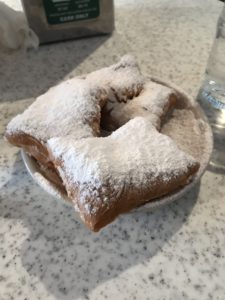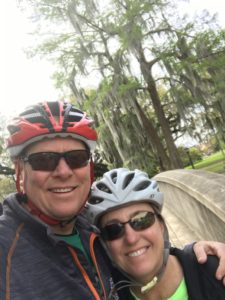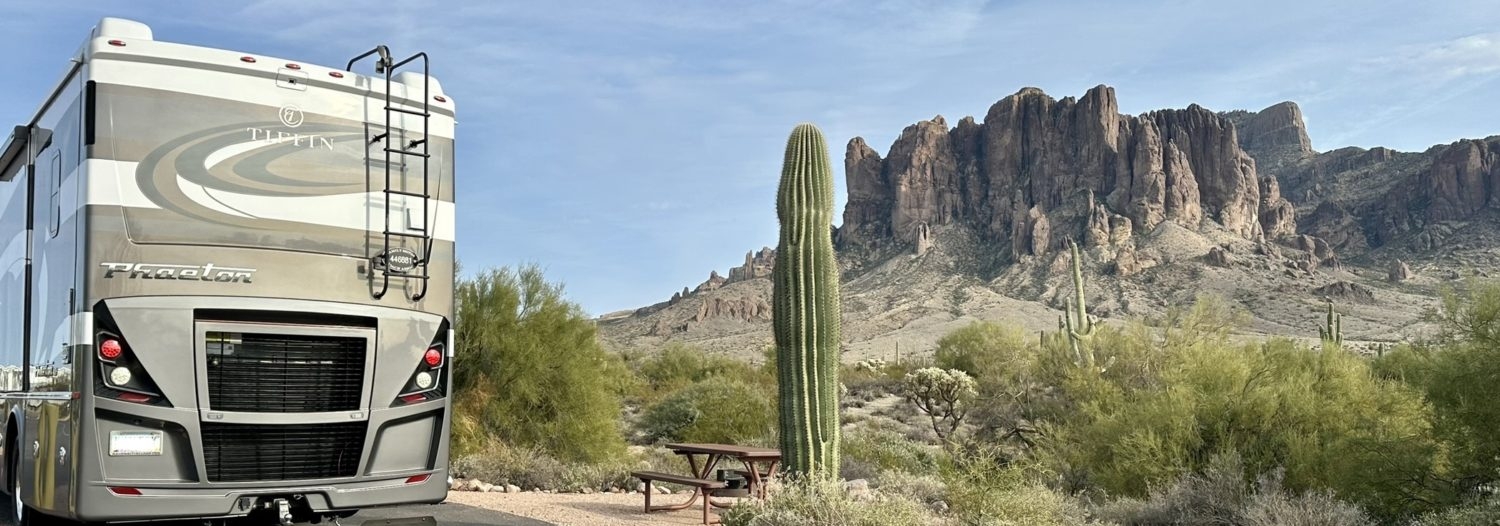My first time to New Orleans was definitely one to remember! We stopped for St. Patrick’s Day weekend on our way home from the FMCA Rally in Georgia. Mark has been several times for work but I was a NOLA newbie for sure.
It was a long drive from Perry to New Orleans and we arrived in the dark. The party had already started, or it just never ended, and the tight streets with people walking everywhere had me on “space alert.” Mark navigated like the pro he is and we were tucked into our space at French Quarter RV Resort in no time. We quickly set up camp and hit the French Quarter.
 As you NOLA veterans know, it’s a feast for all the senses. Sights and sounds were everywhere. We shared a beer and walked, just taking it all in before we found a place to eat. More walking and drinks followed; we walked almost five miles. I was amazed at the sheer volume of people. My first adventure into the French Quarter ended rather late, at least late for us.
As you NOLA veterans know, it’s a feast for all the senses. Sights and sounds were everywhere. We shared a beer and walked, just taking it all in before we found a place to eat. More walking and drinks followed; we walked almost five miles. I was amazed at the sheer volume of people. My first adventure into the French Quarter ended rather late, at least late for us.

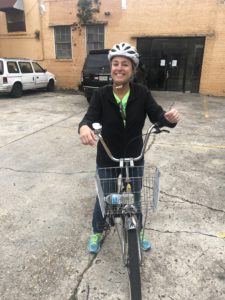
Sunday was a big day. Not only was it St. Patrick’s Day for this Irish lass, we had a morning bike tour scheduled. Our fabulous friends Roger & Mim, meet their daughter in New Orleans when she’s in town for dance events. She is great dancer, finishing in the top 20 of So You Think You Can Dance. Since graduating college, she is making her mark as a dancer and choreographer in Hollywood. Mim hooked us up with her favorite New Orleans bike tour company, Free Wheelin Bike Tours.
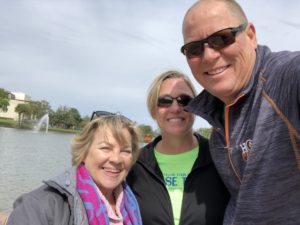 Laura was our tour guide, 4’11” of dynamite packed into a little package. She was born and raised in New Orleans and had great stories around every corner. We ended up getting a private tour, not by design. There was a third person scheduled but she decided not to continue after crashing her bike in the first 20 seconds of pedaling. To be fair, the bikes were pretty heavy and as Laura explained, needed to be extra strength for the uneven surfaces of the streets.
Laura was our tour guide, 4’11” of dynamite packed into a little package. She was born and raised in New Orleans and had great stories around every corner. We ended up getting a private tour, not by design. There was a third person scheduled but she decided not to continue after crashing her bike in the first 20 seconds of pedaling. To be fair, the bikes were pretty heavy and as Laura explained, needed to be extra strength for the uneven surfaces of the streets.
 We rode through lots of neighborhoods, each with their own uniqueness. While we rode, Laura explained the first people to live in this new place called New Orleans were prostitutes, pickpockets and thieves. Apparently the prisons in France were getting too full so large groups were shipped here and each person was baptized Catholic as they got off the boat. That’s why they have parishes instead of counties. As she was talking, I was looking at everything, trying to take it all in.
We rode through lots of neighborhoods, each with their own uniqueness. While we rode, Laura explained the first people to live in this new place called New Orleans were prostitutes, pickpockets and thieves. Apparently the prisons in France were getting too full so large groups were shipped here and each person was baptized Catholic as they got off the boat. That’s why they have parishes instead of counties. As she was talking, I was looking at everything, trying to take it all in.
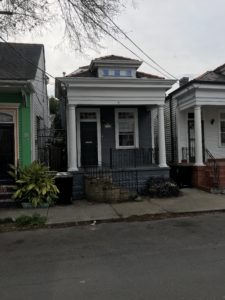
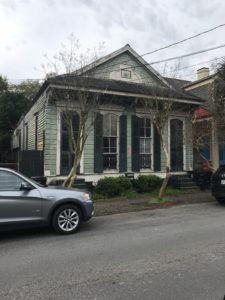
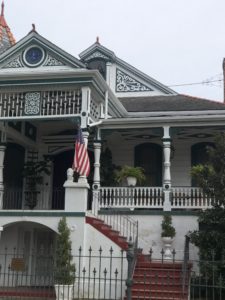
We got to a row of shotgun houses that had been meticulously refurbished. She explained that while there still are many in town, they are a lot few in numbers. We learned something new about shotgun houses, you can have a single or a double shotgun house. As we rode, she pointed out how most of the houses are built a couple of feet above the ground. This was for water of course but also to vent cooler air through the bottom of the house, thus keeping the house a little cooler in the hot summer months. She pointed out original windows that opened at the top and bottom to take advantage of any breeze that might blow through.
I was amazed at the number of old houses still standing. These weren’t new houses made to look 100 years old. Many of these were actually 100 years old. Laura seemed to know everyone, waving at people we passed and asking how they were when they were standing in their yard. Her bicycle bell got a workout, not because we were in danger but because that was her greeting to people.
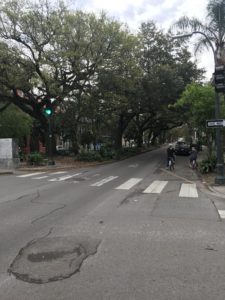 The trees were amazing. I half expected many newly planted trees, especially since the area consistently gets big storms. Instead, we were treated to street after street with beautiful canopies of Live Oak trees.
The trees were amazing. I half expected many newly planted trees, especially since the area consistently gets big storms. Instead, we were treated to street after street with beautiful canopies of Live Oak trees.
Because we drove into town in the dark, we couldn’t see much and missed the cemeteries. I was happy when Laura said she would be taking us to one. I promise, not in a morbid way. I like to meander through old cemeteries, check out the headstones and try to imagine what life was like in the 1800’s or 1700’s. The strength and hardiness of the people, especially in the wild west fascinates me.
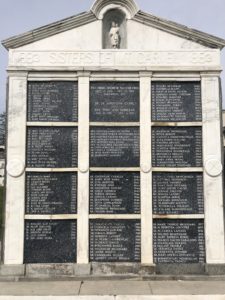
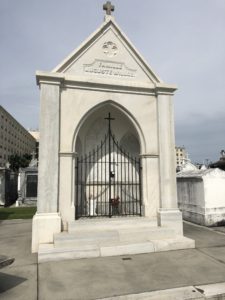
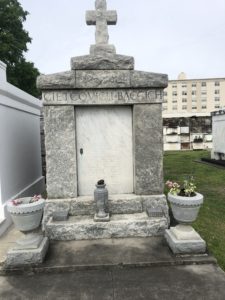
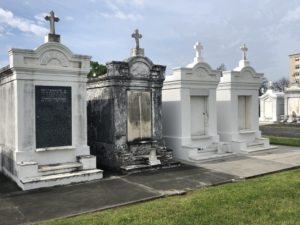

New Orleans cemeteries are a whole different animal. As Laura explained, because the whole area is a swamp, the water table is really high. In the early days of settlement, sometimes bodies would float out after a big storm so the church decided the best way to take care of this was with crypts. She explained the whole process to us. Upon death, the dearly departed was sealed in the crypt in a simple pine box for the grieving period of one year plus one day. Upon that date, the crypt was unsealed and whatever was left of the pine box was removed and the decomposed loved one was swept to the back and over the shelf to spend all of eternity with the rest of the family at the bottom of the crypt. Some of the crypts had 50+ names. There were two very large crypts dedicated to all the priests and nuns that served the area. I kind of liked the idea of everyone being in one place. Mark of course thought about it as only a businessman can, perpetual business requiring much less land. The cost, however, could be rather large ranging from $30,000 all the way up to $500,000 to purchase a crypt. It was simply fascinating.

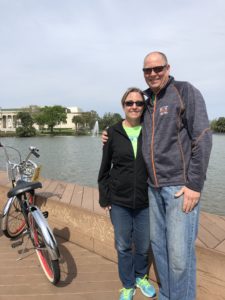
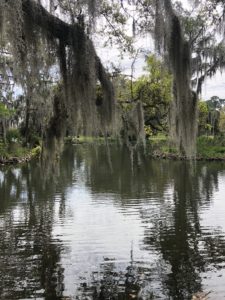
After the cemetery, Laura took us into New Orleans City Park. Here’s your fun fact of the day, City Park is 50% larger than Central Park in New York City and holds the worlds largest collection of mature Live Oak Trees. The park was originally used for dueling which was carried out at the dueling oak tree which still stands. Sadly though, she told us that 1,000 were lost to Katrina. We could have spent an entire day at City Park and not see it all.
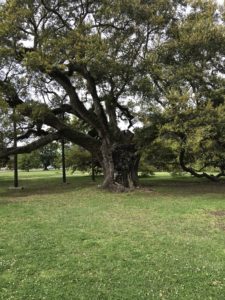

Also in City Park sits the McDonogh Oak, at 805 years young and is the oldest tree in New Orleans. It’s so big I couldn’t get it all in one picture!
Next up was the Treme neighborhood which she told us was the oldest black neighborhood in the US. Here she explained, free people of color lived and played an important role in developing the city’s African-American and Creole culture. As we rode through, Laura was ringing her bike’s bell greeting everyone she saw. It was a neat thing to witness.
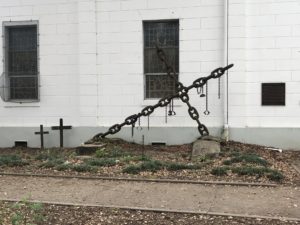 We stopped at St. Augustine Catholic Church. She explained how the free people of color bought pews to make sure everyone had a seat for service. The church sits on a corner and along one street stands a large cross, perched on its side. She explained that it was made from the chains of slaves. I stood there mesmerized, the dark iron against the white walls of the church.
We stopped at St. Augustine Catholic Church. She explained how the free people of color bought pews to make sure everyone had a seat for service. The church sits on a corner and along one street stands a large cross, perched on its side. She explained that it was made from the chains of slaves. I stood there mesmerized, the dark iron against the white walls of the church.
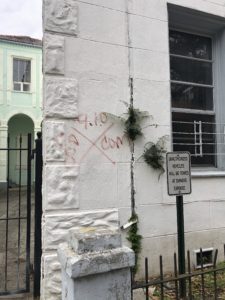 We talked a little about Katrina. Laura told us that her family home fared better than most. She explained that her house stood on a slightly elevated part of the street and her neighbors at the end of the street were not, resulting in considerable damage and flooding. She told of the searching that went on immediately afterward. Each and every building had to be searched, which took some time. Each building was then marked with a giant X with information in each little V that the X made. The search date, what they found, any survivors or victims and the agency doing the searching. Laura painted over hers but said many people chose to leave them as a reminder of what happened and how they’ve survived. One building attached to St. Augustine’s still had their X, perched about 8 feet up on the wall.
We talked a little about Katrina. Laura told us that her family home fared better than most. She explained that her house stood on a slightly elevated part of the street and her neighbors at the end of the street were not, resulting in considerable damage and flooding. She told of the searching that went on immediately afterward. Each and every building had to be searched, which took some time. Each building was then marked with a giant X with information in each little V that the X made. The search date, what they found, any survivors or victims and the agency doing the searching. Laura painted over hers but said many people chose to leave them as a reminder of what happened and how they’ve survived. One building attached to St. Augustine’s still had their X, perched about 8 feet up on the wall.
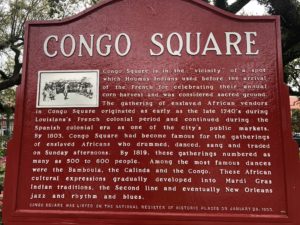
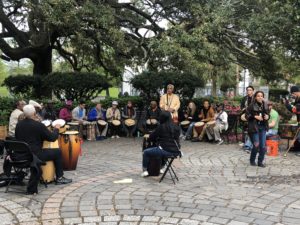
 Our last stop was at Congo Square. You can see the St. Louis Cathedral in the near distance. Laura explained that back in the day, the slaves would gather here while their owners went to mass at the Cathedral. They visited, ate, sang songs and played music. She said that Louis Armstrong played here. A group of musicians gathered as we talked. There were lots of drums, some rhythm instruments and many dancers. Watching this gathering of people making music hearkened back to the very beginning of this park. It was the perfect last stop of the tour.
Our last stop was at Congo Square. You can see the St. Louis Cathedral in the near distance. Laura explained that back in the day, the slaves would gather here while their owners went to mass at the Cathedral. They visited, ate, sang songs and played music. She said that Louis Armstrong played here. A group of musicians gathered as we talked. There were lots of drums, some rhythm instruments and many dancers. Watching this gathering of people making music hearkened back to the very beginning of this park. It was the perfect last stop of the tour.
We had beigniets to find.
